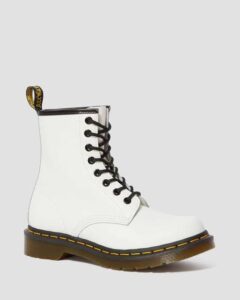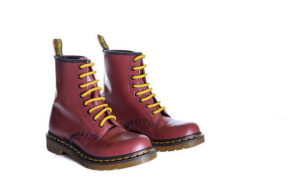Can you hike in Doc Martens? have been used as work boots, for gardening, urban wear, and fashion statements. Nowadays, these boots aren’t associated with rugged outdoor activities, mostly because people choose to invest in traditional hiking boots. However, Doc Marten boots were originally designed to be used solely as field boots. That said, there are some features that the Doc Martens share with proper hiking boots that make them ideal for some hikes, such as the leather uppers. So, are Doc Martens good for trail hiking? Below, we’ll take a closer look at this brand and some associated footwear and find out whether or not these are really trail-worthy products.
To begin with, delving into the history of Doc Martens raised the question of whether there could be some legitimacy to the notion that Docs are suitable for hiking. Surprisingly, these fashionable boots originated as work boots. In the 1940s, a German doctor named Klaus Märtens designed the leather, mid-calf, lace-up boots as an alternative to his standard-issue army boots. The initial release gained immense popularity, especially among housewives and gardening enthusiasts.
Due to their current fashionable and urban image, Doc Martens are not typically linked with rugged outdoor activities. However, considering their original purpose, there might be common characteristics with modern hiking boots. To address this question, we conducted a test using our criteria for selecting hiking boots to ascertain whether Doc Martens can indeed serve as suitable footwear for a hike.

Features of Doc Martens
Doc Martens are leather footwear designed in the 1940s by a German doctor as a new kind of work boot. The Dr. Martens 2976 Chelsea and Smooth Leather Jadon Platform boots are popular products with a sleek and minimalist appearance, best suited for casual settings. The comfort, breathability, and weight of Doc Marten boots have features that play into the advantages and disadvantages of wearing them for hiking.
The very first product, the Doc Marten 1460, was designed with an air-cushioned rubber sole, a smooth leather upper, yellow stitching around the boot, and a high ankle collar that extends to the lower portion of the calf. The 1460 is an important model to take note of not only because it’s the very first Doc Marten product but also because it serves as the template for every other boot in the brand’s line of footwear.
While you can hike in Doc Martens, it’s not ideal. However, if you do end up using these boots for hiking, it’s best to limit yourself to easy and flat trails. Even though Doc Martens have durable leather uppers and collars that extend above the ankles and offer protection and ankle support, they lack the comfort, breathability, and traction to be used on a real hiking trail. Since these shoes were made for urban wear, they have nearly no features that would make them reliable on dry or slippery rocks, stepping over branches, or even climbing.
Additionally, their weight makes them a little heavier than regular hiking shoes. On average, a pair of size 9 Doc Martens weighs around 3 lbs. This is significant compared to the Salomon X Ultra 4 Mid GTX, a shoe that weighs 1lb. 14. oz. at the same size. This is even more eye-opening when you remember that the X Ultra 4 is made specifically for hiking while boasting even more features.
Most Popular Doc Martens Hiking Boots:
They are sleek footwear designed with durable leather and elastic gussets. Even though the uppers have a soft sheen, they’re still a little stiff, giving a new pair of 2976 Chelsea boots a break-in time before the leather starts to move naturally with your foot. Since the ankle collar stretches well, the 2976 Chelsea boots are easy to slip on and off. The leather and sole are sealed with heat treatment, making the boots more resistant to premature wear and tear.
Overall, these boots are reliable in casual settings, despite their rigid build. They also have the original air-cushioned sole, providing comfort for long periods of standing. Like the 2976 Chelsea Boots, these fit better in urban settings than outdoor settings but can still handle traveling on flat trails.

Advantages of Using Doc Marten’s Boots for Hiking:
– Traction tread and traction: Doc Martens have a soft rubber outsole to manage wet and oily surfaces, making them suitable for dry climates and even more so in rainy conditions.
– Durability: They were made to be rugged and tough enough to stand up to demanding work conditions, which might improve the lifespan of Doc Martens on some trails. While hiking in Doc Martens may have a few advantages, let’s see why you should avoid walking long distances with a Doc Marten boot.
Disadvantages of Using Doc Martens Boots for Hiking:
– Breathability: The leather uppers of Doc Martens are not well-ventilated like regular hiking boots, which can lead to discomfort on a hiking trail.
– Weight: Doc Martens on average weigh close to 3 lbs. a pair, making them bulkier than good hiking boots, hiking shoes, and trail running shoes.
– Comfort: The smooth leather is incredibly stiff, and there’s a significant break-in period, making the boot inflexible and potentially causing pain and blistering on a trail.
Considering all these factors, we concluded that while Doc Martens may not be the most ideal option for hiking due to their weight, limited waterproofing, questionable ankle protection, and tendency to cause rubbing, they still fare better than choosing to hike in jeans
Should You Recommend Doc Martens for Hiking?
In the end, no, we do not recommend hiking in Doc Martens. While they are high-quality boots, they are not made for the outdoors. The tough leather protects your feet from foreign objects, but that’s about it. Even after breaking in, they lack the cushioning, weatherproofing, and stability necessary for rugged or rocky terrain. Doc Martens are designed exclusively for fashion and utility in urban settings. For your hiking needs, it’s better to explore brands that specialize in hiking boots.


